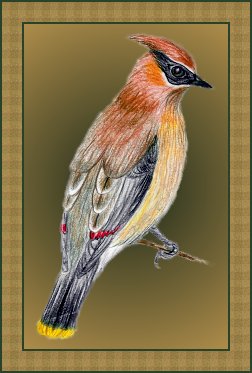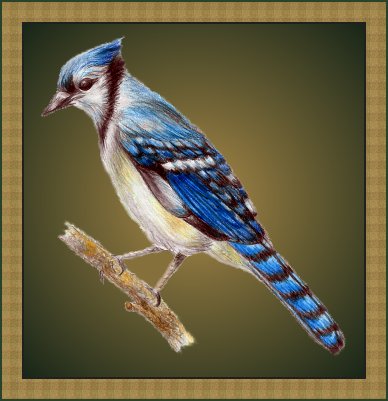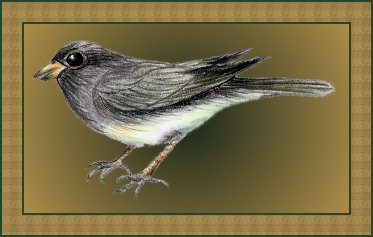I originally did the page, "Birds of Winter", to be a lone page while I awaited spring, but it seemed like such a good idea that I did a page for the birds of each season. So I give to you the Birds of Spring, even though some are year round visitors. My favorite bird that returns each spring is the hummingbird, and in this area, western North Carolina, that is the Ruby-throated Hummingbird.
 The Cedar Waxwing (Bombycilla cedrorum) is about 7 inches in length and is very easy to recognize. They love to eat wild fruit, insects, and especially berries. They are found in this area (western North Carolina) year round, but they move around to eat the food that is available and will leave an area once the food is exhausted. Because of this, you will find them in the woods, rural and suburban areas, but never in one place for very long. They tend to nest in the late summer when there is a good supply of small fruits and berries to feed their young. They build nests of grasses, twigs, and mosses lined with fine materials in the fork or branch of a tree 4 to 50 feet above the ground. They lay 2 to 6 eggs that are pale blue with dark marks. They are a very social bird that will perch in a row with lots of other waxwings, passing a berry or insect down the line and back again, bill to bill, until one bird eats it. They will even do this during nesting season, unlike other birds that tend to stay and feed together only in nesting pairs.
The Cedar Waxwing (Bombycilla cedrorum) is about 7 inches in length and is very easy to recognize. They love to eat wild fruit, insects, and especially berries. They are found in this area (western North Carolina) year round, but they move around to eat the food that is available and will leave an area once the food is exhausted. Because of this, you will find them in the woods, rural and suburban areas, but never in one place for very long. They tend to nest in the late summer when there is a good supply of small fruits and berries to feed their young. They build nests of grasses, twigs, and mosses lined with fine materials in the fork or branch of a tree 4 to 50 feet above the ground. They lay 2 to 6 eggs that are pale blue with dark marks. They are a very social bird that will perch in a row with lots of other waxwings, passing a berry or insect down the line and back again, bill to bill, until one bird eats it. They will even do this during nesting season, unlike other birds that tend to stay and feed together only in nesting pairs.
 I find Blue Jays (Cyanocitta cristata) are the best imitator of other bird sounds. When I hear what I think is a hawk, and go to check that one isn't stalking my feeders, I will usually find a Blue Jay. The Blue Jay is around 11 inches long. There is no doubt when you have Blue Jays in your yard as they are very vocal, and are easy to recognize due to their distinctive color and patterns. They eat acorns and other nuts, insects, bird eggs, and nestlings, but will come to feeders for the sunflower seeds and cracked corn. Blue Jays are found in all kinds of woods and suburbs, and they build their nest of twigs, bark, leaves, and human-made objects, lined with fine rootlets. They lay 4 to 5 eggs that are greenish blue with brown spots. They, like crows, will actively pursue owls and hawks. I'm not sure why owls and hawks put up with it, since they are much larger. I guess a crowd of noisy Blue Jays is better just avoided than being confronted.
I find Blue Jays (Cyanocitta cristata) are the best imitator of other bird sounds. When I hear what I think is a hawk, and go to check that one isn't stalking my feeders, I will usually find a Blue Jay. The Blue Jay is around 11 inches long. There is no doubt when you have Blue Jays in your yard as they are very vocal, and are easy to recognize due to their distinctive color and patterns. They eat acorns and other nuts, insects, bird eggs, and nestlings, but will come to feeders for the sunflower seeds and cracked corn. Blue Jays are found in all kinds of woods and suburbs, and they build their nest of twigs, bark, leaves, and human-made objects, lined with fine rootlets. They lay 4 to 5 eggs that are greenish blue with brown spots. They, like crows, will actively pursue owls and hawks. I'm not sure why owls and hawks put up with it, since they are much larger. I guess a crowd of noisy Blue Jays is better just avoided than being confronted.
 I absolutely love the Ruby-throated Hummingbird (Archilochus colubris), and I feel that spring has truly arrived when I spot the first one of the season. At 3 1/2 inches in length, they are a very small bird. For what they lack in size they make up for in aggressively defending the feeder! They are fearless and curious. They have flown up to my sliding glass door and looked in at me. They fly up to the plant window and try to find a way into the flowers there. Hummingbirds can be difficult to photograph, as they won't let you get too close. I have set up a camera with a zoom lens on a tripod and prepared to wait, only to have them fly right up to the camera to check it out. Naturally they are too close to photograph. They eat flower nectar, insects, spiders, sap from sapsucker-drilled holes, and nectar from feeders. They are found in the woods, near streams, parks, gardens, and near any home that has feeders. It may take them a while to find your feeder, but I have always had them come no matter where I lived. They build nests of plant down, bud scales, and cover it with lichens that are bound with spider's silk on a small horizontal limb 10 to 20 feet off the ground. They usually lay 2 eggs that are white. The female builds the nest and raises the young alone. One of the most amazing facts about the Ruby-throated Hummingbird is that the male weighs about the same as 2 1/2 paperclips, and all of them migrate 600 miles across the Gulf Of Mexico! I have some more information on Hummingbirds in general on my
Hummingbirds page.
I absolutely love the Ruby-throated Hummingbird (Archilochus colubris), and I feel that spring has truly arrived when I spot the first one of the season. At 3 1/2 inches in length, they are a very small bird. For what they lack in size they make up for in aggressively defending the feeder! They are fearless and curious. They have flown up to my sliding glass door and looked in at me. They fly up to the plant window and try to find a way into the flowers there. Hummingbirds can be difficult to photograph, as they won't let you get too close. I have set up a camera with a zoom lens on a tripod and prepared to wait, only to have them fly right up to the camera to check it out. Naturally they are too close to photograph. They eat flower nectar, insects, spiders, sap from sapsucker-drilled holes, and nectar from feeders. They are found in the woods, near streams, parks, gardens, and near any home that has feeders. It may take them a while to find your feeder, but I have always had them come no matter where I lived. They build nests of plant down, bud scales, and cover it with lichens that are bound with spider's silk on a small horizontal limb 10 to 20 feet off the ground. They usually lay 2 eggs that are white. The female builds the nest and raises the young alone. One of the most amazing facts about the Ruby-throated Hummingbird is that the male weighs about the same as 2 1/2 paperclips, and all of them migrate 600 miles across the Gulf Of Mexico! I have some more information on Hummingbirds in general on my
Hummingbirds page.
 The American Robin (Turdus migratorius) is found here year round, and is about 10 inches in length. They can be often seen hopping around on lawns or in fields or meadows looking for earthworms. They also eat insects, fruits , and berries. Robins may come to a feeder for fruit. They live in almost any habitat, like woods, open lawns, meadows, and they will nest quite close to a house. Robins built their nests of grasses, with a middle layer of mud, and line the nest with fine grasses. You may even see a female with mud across her breast due to pressing it against the muddy lining as she forms the inner part of the nest. They will build the nest on a horizontal limb of shrubs or trees or on building edges about 5 to 20 feet off the ground. Robins lay 3 to 7 eggs that are light blue. Robins sing the most just before the young hatch. After breeding season, robins flock together and sleep in large communal roosts at night from fall through winter.
The American Robin (Turdus migratorius) is found here year round, and is about 10 inches in length. They can be often seen hopping around on lawns or in fields or meadows looking for earthworms. They also eat insects, fruits , and berries. Robins may come to a feeder for fruit. They live in almost any habitat, like woods, open lawns, meadows, and they will nest quite close to a house. Robins built their nests of grasses, with a middle layer of mud, and line the nest with fine grasses. You may even see a female with mud across her breast due to pressing it against the muddy lining as she forms the inner part of the nest. They will build the nest on a horizontal limb of shrubs or trees or on building edges about 5 to 20 feet off the ground. Robins lay 3 to 7 eggs that are light blue. Robins sing the most just before the young hatch. After breeding season, robins flock together and sleep in large communal roosts at night from fall through winter.
 The Northern Mockingbird (Mimus polyglottos) is a year round bird in this area. It is about 10 inches in length.
I do not usually see them at my feeders, but have seen quite a few in open areas like parks and gardens. They eat insects, snails, crayfish, lizards, small snakes, wild fruits, and berries. They live in open areas with shrubs, gardens, and parks. Mockingbirds build a nest of twigs, plant stems, mosses, cloth, string, and dry leaves. They place the nest in shrubs or trees 3 to 10 feet off the ground. They lay 2 to 6 eggs that are blue-green with brown marks. An agressive bird, the Northern Mockingbird, will form territories of about 1 to 2 acres, twice a year, and defend it against any potential predator including cats, snakes, and people! It's song will mimic other birds, and they will sing at night. Mockingbirds also imitate sounds of frogs, crickets, dogs, and others. They are somewhat easy to identify in flight with their bold white patches on their wings. The Northern Mockingbird does have a secretive cousin, the Bahama Mockingbird (Mimus gundlachii), that is found only in the very southern end of Florida to the Keys (in this country).
The Northern Mockingbird (Mimus polyglottos) is a year round bird in this area. It is about 10 inches in length.
I do not usually see them at my feeders, but have seen quite a few in open areas like parks and gardens. They eat insects, snails, crayfish, lizards, small snakes, wild fruits, and berries. They live in open areas with shrubs, gardens, and parks. Mockingbirds build a nest of twigs, plant stems, mosses, cloth, string, and dry leaves. They place the nest in shrubs or trees 3 to 10 feet off the ground. They lay 2 to 6 eggs that are blue-green with brown marks. An agressive bird, the Northern Mockingbird, will form territories of about 1 to 2 acres, twice a year, and defend it against any potential predator including cats, snakes, and people! It's song will mimic other birds, and they will sing at night. Mockingbirds also imitate sounds of frogs, crickets, dogs, and others. They are somewhat easy to identify in flight with their bold white patches on their wings. The Northern Mockingbird does have a secretive cousin, the Bahama Mockingbird (Mimus gundlachii), that is found only in the very southern end of Florida to the Keys (in this country).
 The Dark-eyed Junco (Junco hyemalis) is a small bird at 6.25 inches in length. I have pictured the "slate-colored" variety that I have seen here at the house. There are 6 different color variations in this country, with the slate-colored one being found here year round. They all have a pale bill, but the body colors vary greatly. Juncos feed mostly on the ground and eat weed and grass seeds. They summer in the deeper parts of the woods, bogs, in the mountains above tree level, but will winter closer in the wood edges and brush. I typically see them only in the winter. Juncos build cuplike nests of grasses, moss, pine needles, and line them with rootlets. They place their nests in depressions on the ground near tall vegetation. They lay 3 to 6 eggs that are gray or pale bluish with dark blotches. Junco flocks return to the same areas each winter. They have flocks of fixed members and have a hierarchy, where aggression at feeders is their expression of dominance.
The Dark-eyed Junco (Junco hyemalis) is a small bird at 6.25 inches in length. I have pictured the "slate-colored" variety that I have seen here at the house. There are 6 different color variations in this country, with the slate-colored one being found here year round. They all have a pale bill, but the body colors vary greatly. Juncos feed mostly on the ground and eat weed and grass seeds. They summer in the deeper parts of the woods, bogs, in the mountains above tree level, but will winter closer in the wood edges and brush. I typically see them only in the winter. Juncos build cuplike nests of grasses, moss, pine needles, and line them with rootlets. They place their nests in depressions on the ground near tall vegetation. They lay 3 to 6 eggs that are gray or pale bluish with dark blotches. Junco flocks return to the same areas each winter. They have flocks of fixed members and have a hierarchy, where aggression at feeders is their expression of dominance.